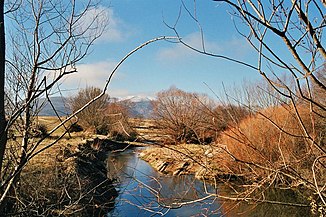Adaja
| Río Adaja | ||
|
Upper reaches of the Río Adaja in the Valle de Amblés |
||
| Data | ||
| location | Avila Province , Spain | |
| River system | Duero | |
| Drain over | Duero → Atlantic | |
| source |
Iberian Scheidegebirge 40 ° 31 ′ 26 ″ N , 5 ° 9 ′ 48 ″ W |
|
| Source height | approx. 1300 msnm | |
| muzzle |
Duero coordinates: 41 ° 31 '59 " N , 4 ° 51' 48" W 41 ° 31 '59 " N , 4 ° 51' 48" W. |
|
| Mouth height | approx. 675 msnm | |
| Height difference | approx. 625 m | |
| Bottom slope | approx. 3.8 ‰ | |
| length | approx. 163 km | |
| Catchment area | 5328 km² | |
| Drain |
MQ |
10.9 m³ / s |
| Left tributaries | Arevalillo | |
| Right tributaries | Eresma | |
| Reservoirs flowed through | Embalse del Castro de las Cogotas | |
| Medium-sized cities | Ávila | |
| Small towns | Arévalo | |
| Communities | Villatoro , El Fresno , Valdestillas | |

The Adaja is an approximately 163 km long left tributary of the Duero in the Spanish province of Ávila in the autonomous region of Castile-León .
course
The source of the Río Adaja, also called Fuente Berroqueña , is located on the north side of the Iberian Divisional Mountains ( Sierra de Guadarrama ) in the municipality of Villatoro . His path initially leads through the Amblés Valley, which is around 1000 m high, in an easterly and northeastern direction to Ávila . Shortly before the provincial capital, the river makes a bend to the north and maintains this direction of flow until it flows into the Duero approx. 2 km north of Villanueva de Duero .
Tributaries
After the snow melts and after heavy rainfall, a large number of streams (arroyos) flow into the Río Adaja; however, most of them run out of water in summer and autumn. The two largest permanent water-bearing tributaries are the Río Arevalillo and the Río Eresma .
Reservoirs
Embalse del Castro de las Cogotas (capacity max. 59 hm³, surface max. Approx. 394 ha; height of the dam 67 m)
Ecosystem
- fauna
Despite the deforested and agriculturally used landscape on both sides of the Río Adaja, various fish species from the families of the wolffish and carp fish , as well as crayfish, live in the largely natural river .
- flora
The riparian vegetation along the Río Adaja is very species-rich. In addition to willows , hawthorn , ash and poplar grow there .
Places on the river
Blacha, Baterna, Niharra , El Fresno , Ávila , Arévalo , Calabazas, Villalba de Adaja , Valdestillas , Los Doctrinos
Attractions
The main attraction on the river is the city of Ávila with its medieval city wall, the cathedral and the Romanesque churches of San Vicente , Santo Tomé and San Pedro outside the city wall . The city of Arévalo with its castle (castillo) and its Mudéjar churches is also worth seeing. In some villages along the Valle de Amblés , Celtic animal sculptures ( verracos ) have been erected, which originally may have belonged to Vettonic high fortresses (e.g. Castro de Las Cogotas or Castro de Ulaca ).
